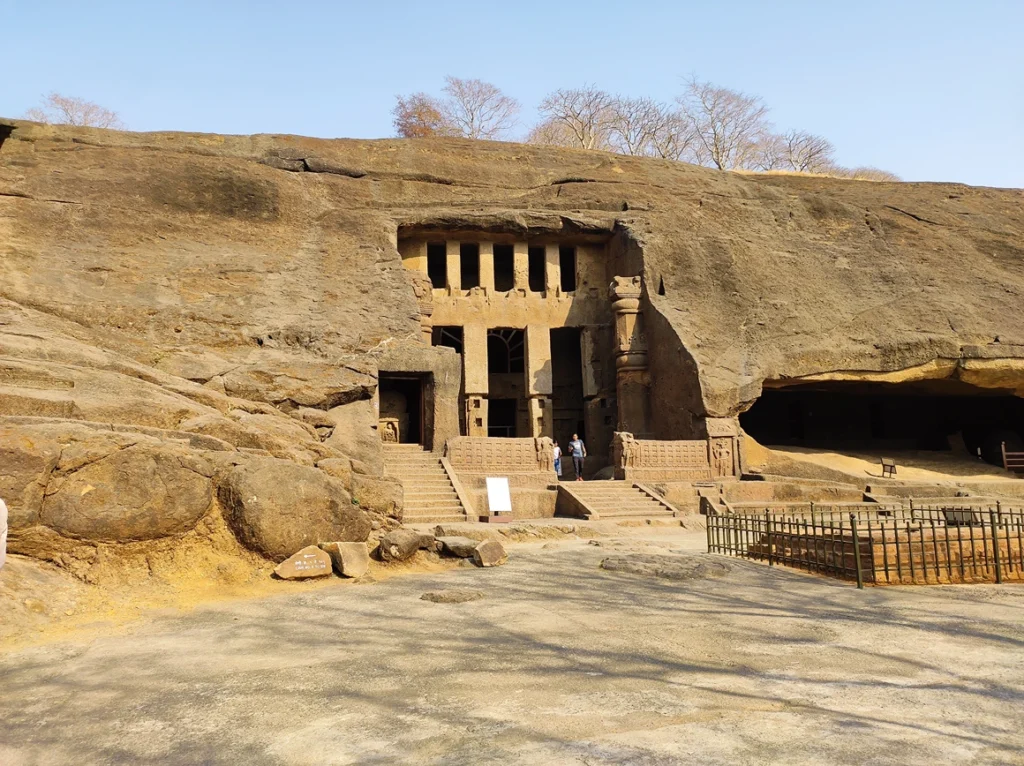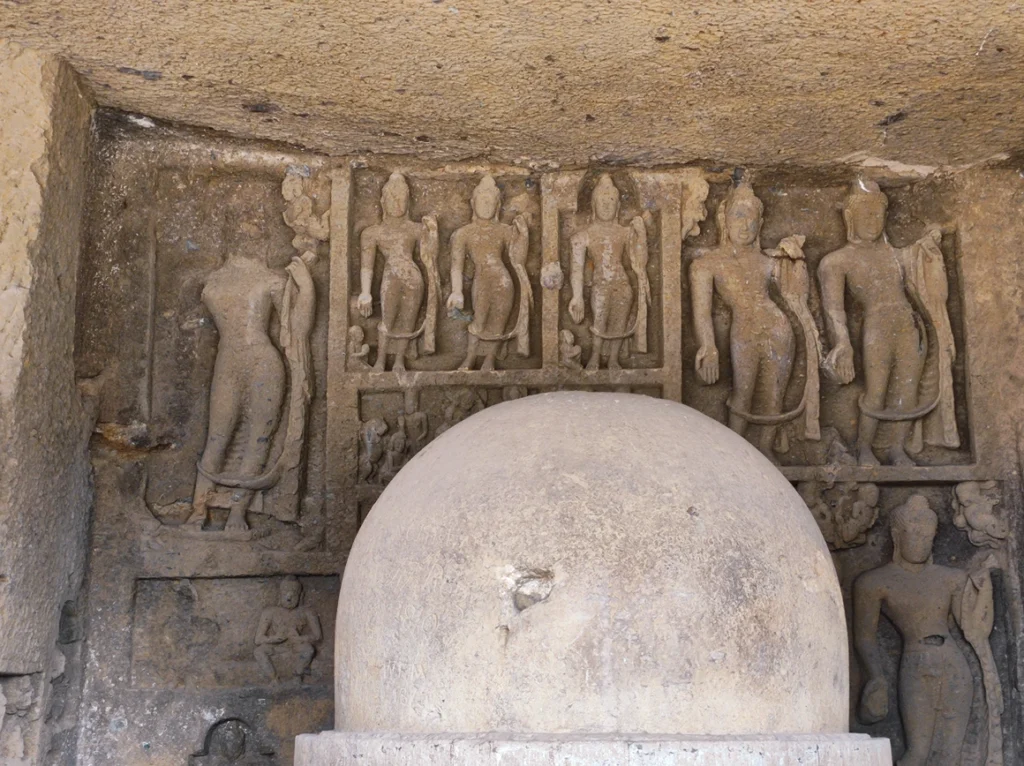The term “Kanheri” comes from the Sanskrit phrase “Krishnagiri,” which translates to “black mountains.” The Sanjay Gandhi National Park’s woodlands are home to the Kanheri Caves, a collection of caves and mountains carved out of rocks.
Salsette Island, on the western edge of Bombay, is where it is located. Buddhist sculptures from the first century BCE to the tenth century CE are inscribed on the rock. The cave complex contains 109 chambers made of basalt rock.

Being a very old cave, as opposed to other heavily decorated elephant caves, the design is ornamented and straightforward. A Buddhist shrine can be seen on each stone pillar in the cave.
Buddha carvings were added to the cave monastery’s walls by the end of the third century, making Kanheri Caves Mumbai a Buddhist community.

Buddhists primarily utilised the majority of the caves for living, studying, meditating, and teaching. The large ones are for worship, intricately carved with Buddhist stupas. This place of worship was often established to teach us the moral principles we should uphold. Kanheri Caves built by Buddhist monks
Kanheri Caves History:
The caves date back to between the first and ninth centuries BCE. Among the basalt rocks, 139 caves have been hollowed out. Each cave has a stone plinth that serves as a bed. Comparing these caves to the luxurious Elephanta caves nearby reveals how drastically different they are.

The meeting hall, which features enormous stone pillars, is where the Buddhist shrine, a stupa, is located. As you climb the hills, there are traces of old canals, cisterns, and water systems. They gathered rainwater and directed it into enormous reservoirs.
Intricate carvings of Buddha and bodhisattvas were done on the cave walls as the caves evolved into Buddhist monasteries. In the third century AD, it was a significant Buddhist monastery in the Konkan coastal area.
Buddhist monks lived, studied, and meditated in most of these caves. The congregational worship rooms were the enormous caves known as Chaityas. The Chaityas for worship were bordered with sculptures, reliefs, elaborate Buddhist pillars, and rock-cut stupas.

The most significant character is Avalokiteshvara. He is a bodhisattva who embodies all of the Buddha’s compassion. His veneration is widespread in Mahayana Buddhism.
The information found in these caverns offers hints about the once-established world of Buddhist monks. Trade hubs were connected to it, including the ports of Kalyan, Nasik, Paithan, Sopara, and Ujjain. Kanheri was a centre for higher learning throughout the reigns of the Kushan and Mauryan Empires. Atisha, a Buddhist instructor, travelled to Kanheri in the latter part of the 10 century to study Buddhist meditation under Rahul Gupta.
The architecture of Kanheri Caves
The Kanheri Caves Mumbai feature viharas, stupas, prayer halls, and other structures of old-style Buddhist architecture. These caves’ carving out of a single bedrock is their most distinctive feature. The construction of the caves is relatively straightforward, but they are expertly planned with functional elements like stone platforms for sleeping, channels to collect and store rainwater, lofty pillars, walkways, etc.

The several caverns here have unique features, such as Cave 1’s incomplete chaitya griha and Cave 2’s three stupas and carved Buddha statues. A stupa, lofty pillars, and a sizable statue of Lord Buddha may be found near the entrance to Cave 3. The caverns also include several Devanagari and Brahmi inscriptions, most of which are still unrevealed.
Where is Kanheri Caves
Kanheri Caves is a green and open tourist destination located on the outskirts of Mumbai, away from the noise and bustle of the city. On a hillside, this tranquil cave complex is accessible through steps carved out of the rocks.
Things to do at Kanheri Caves
- Sanjay Gandhi National Park Safari

A lovely, verdant forest region called Sanjay Gandhi National Park is situated in Mumbai. Moreover, it is India’s largest forest area and is situated in a big city. The park is home to numerous tigers and other wild animals in the area, as well as a broad variety of flora and wildlife.
In this park, various wild species, including tigers, elephants, spotted and black deer, etc., can be seen freely roaming the jungle. The fact that the animals are not in cages is an advantage for the park. The park offers a variety of safari options, and visitors can see a variety of uncommon plants, birds, and wild animals in this forested environment.
- Film City
One of the most well-known tourist destinations close to the Mumbai Kanheri Caves is the Film City, which is only a short ride away. This location, on the fringes of Sanjay Gandhi National Park, is used to film important Indian films, particularly Hindi language films (Bollywood).
The tourists’ trip to film city would provide them insight into how the film business operates. Also, if they are fortunate, tourists may have the opportunity to interact with some of the most well-known figures from Bollywood, the Indian film industry.
- Go to Tulsi Lake
Tulsi Lake is a freshwater lake in a forested location around 6-7 miles from Kanheri Caves in Mumbai. The second-largest source of drinking water in Mumbai is Tulsi Lake. Drinking Tulsi Lake’s freshwater is a joyous experience. The lake is a haven for many wild creatures because it is located in a forest. Hence, to visit the lake, permission from the forest department is needed. A local tour guide can be useful.
- Jambhulmal Peak
The Jambhulmal Peak is thought to be the tallest mountain in Mumbai’s forest area. Visitors may easily approach the highest point because it is close to the Kanheri Caves. The peak rises above sea level by more than 1847 feet and provides a stunning view of the city. The tourists can enjoy the calming sound of birds chirping while discovering numerous uncommon flower species.
- Chota Kashmir, Mumbai
Chota Kashmir, is a picnic area away from the bustle and commotion of Mumbai city, located close to Film City. It is a must-go-to location for tranquillity and relaxation and was named after Kashmir, India. Several tourists come here with their families. The location provides access to lake boating. A great destination to visit with family or friends is Chota Kashmir.
Interesting Facts about Kanheri Caves
- At Kanheri Caves in Mumbai, there are more than 109 caverns.
- Nearly every cave contains a small platform constructed entirely of stone.
- Large assembly halls are supported by enormous pillars in several of these caves.
How to Reach Global Kanheri Caves
Inside Sanjay Gandhi National Park, on the outskirts of Mumbai, lies the Kanheri Caves. This well-liked location is popular with both locals and tourists seeking quick escapes. As a result, a network of BEST buses and local trains connect to Kanheri’s caves.
To reach Kanheri Caves, you need to come to Sanjay Gandhi National Park. There is frequent Bus service that goes directly to Kanheri Caves which cost one way journey ₹25.

By Road –
If travelling by road via personal vehicle or cab. Sanjay Gandhi National Park can be easily accessed by road from the Western Express Highway(WEH). Reach Borivali on Western Express Highway, and you will find the main gate entrance near the National Park Flyover.

By Rail –
If travelling by train, one can easily reach from Borivali railway station. Get down at Borivali station, and take the BEST bus or Auto-Rickshaw to reach Sanjay Gandhi National Park.
By Air –
Mumbai, the city of dreams, has connections to several places worldwide. After all, it is regarded as India’s entryway. The distance between the airport and the SGNP is roughly 15 kilometres. Hire a cab from the airport to reach the place.
Conclusion
If you are interested in Buddhism, old architecture, history, or just enjoying spending time in nature, Kanheri Caves is a must-see. As a result, it is strongly advised that you include Kanheri Caves in your itinerary anytime you travel to Mumbai.
If you’re taking a train or a flight to Mumbai, don’t forget to purchase your tickets in advance. Moreover, look up lodging possibilities online and decide in advance. You can simply reserve a hotel in Mumbai that meets your demands and budget because there are many hotels close to Kanheri Caves.
